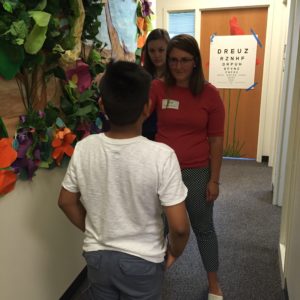Building a patient base as a new optometrist can be challenging. However, providing a service for your community, such as a vision screening, will both set you apart and also attract new families to your practice. This article will hopefully provide stepping stones for creating relationships with schools, performing vision screenings, and following up with schools regarding children who do not pass the screenings. 
What can you do now, as an optometry student? Get involved. There is no better way to learn how to organize an effective screening than getting involved and helping with screenings while in optometry school. If this is an area than interests you, reach out to your school’s outreach coordinator, and possibly help coordinate screenings with your optometry school’s support.
1. Reaching out to schools:
As we all know, the first step of accomplishing anything is getting your foot in the door! Therefore, finding the correct contact person at a school is a priority. Some examples of good people to contact at schools include nurses, school counselors, and principals.
Perseverance is key. If the first person you contact is not receptive, ask someone else! PTAs (Parent Teacher Associations) are another wonderful group to contact. PTAs are usually organized by active parents–parents who would be receptive if you present the importance of eye exams for their children.
2. Provide education materials for teachers and school staff:
- Hand out a checklist of signs and symptoms related to vision problems (a good overview can be found here).
- Take the time to educate teachers and staff about the importance of vision in learning. Bradley Jansen, a Pacific University optometry student, surveyed teachers from 23 institutions in Oregon and Washington to better understand teachers’ level of familiarity with the role vision plays in child development. He found that only 10% of teachers were educated on vision problems in children. However, more than two-thirds supported having access to an Open Educational Resource (OER) related to vision and academic development in children. In-service days provide a wonderful opportunity to educate teachers on this topic.
3. Send home permission slips to parents before the screening:
Include a form explaining the difference between a vision screening and a comprehensive eye exam and the importance of each. Unfortunately, many parents often confuse a school vision screening for a comprehensive eye exam.
4. Create a plan with the school for the day of the screening:
- Solidify which room(s) the screening will take place in–libraries, cafeterias, or extra classrooms work well. Remember, a dark room is desirable when performing retinoscopy. Additionally, try to use 10-foot charts when measuring visual acuity to accommodate working in smaller spaces.
- Decide what children will be screened and what time of day they will be pulled out of class that would least interfere their education.
5. The vision screening:
- Recruit volunteers to help, leading to a more efficient process and allowing students to focus on clinical skills.
- Have an exam form created specifically for screenings. The form should include a “Recommendations” and “Plan” section, among other headers.
- Useful screening tests include VAs, pupils, near cover test, near point of convergence (NPC), extraocular motilities (EOMs), stereopsis, color vision, direct ophthalmoscopy, and retinoscopy.
- Additional tests could include autorefraction, intraocular pressures, and hand-held slit lamp examination.
- Don’t forget alcohol swabs, hand sanitizer, and Kimwipes!
6. Send a note home to parents of children with detected vision abnormalities:
Include an explanation of abnormal findings, in layman’s-terms. Don’t forget to include referral information for a comprehensive eye exam at your office!
7. Follow up:
- Provide the school with copies of the screening results to place in student files.
- For students who failed the screening, send home a letter to the child’s parents/guardians describing in layman’s terms why the student did not pass.
- Finally, make sure to follow up with the school to ask for feedback on how to improve future vision screenings.
Setting up a vision screening program can be a difficult process, but never lose sight of the incredible service you are providing kiddos! Demonstrating the significance of your screenings creates life-long relationships with schools that could hopefully result in more prestige, recognition, and business!
Acknowledgements:
- Dr. Sarah Martin O.D., Outreach Coordinator at Pacific University College of Optometry
- Jansen, Bradley. (2016). Educating Teachers About Children’s Vision (Master’s Thesis).

